Categories
Left column house ads
Cooking Like Nobu Matsuhisa
September 12, 2012 Restaurant/Bar News
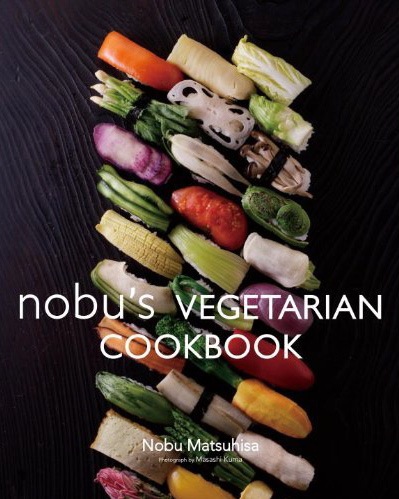 I approached Nobu’s Vegetarian Cookbook with some excitement. Unlike the other cookbooks in this series—Andrew Carmellini’s American Flavor, Kurt Gutenbrunner’s Neue Cuisine, and Aarón Sánchez’s Simple Food, Big Flavor—I wouldn’t have to root around for the meat-free options. And while I couldn’t immediately think of any vegetarian dishes I had had at a Nobu restaurant, I could imagine what to expect (and Adam has had much success with the recipe for miso black cod from Nobu: The Cookbook). Plus, look at that cover! The entire book is gorgeous.
I approached Nobu’s Vegetarian Cookbook with some excitement. Unlike the other cookbooks in this series—Andrew Carmellini’s American Flavor, Kurt Gutenbrunner’s Neue Cuisine, and Aarón Sánchez’s Simple Food, Big Flavor—I wouldn’t have to root around for the meat-free options. And while I couldn’t immediately think of any vegetarian dishes I had had at a Nobu restaurant, I could imagine what to expect (and Adam has had much success with the recipe for miso black cod from Nobu: The Cookbook). Plus, look at that cover! The entire book is gorgeous.
The Menu
As I flipped through, however, I grew discouraged. Many of the recipes require deep-frying or obscure ingredients (udo stem, tossa jute leaves, mountain yam, agar powder, Okyuto gellied agar sheet—and that’s just the first six recipes). I don’t allow deep-frying at home—our kitchen has no vent to the outside—and I didn’t want to spend days tracking down ingredients. Also, I scratched anything that called for truffles. If I had a truffle lying around, I’d scramble eggs and call it a night.
Over and over again I got excited about a recipe, only to find that it was more complex than I had thought—the recipes tend to involve a subrecipe or two, which are grouped together in the back of the book. I understand this made more room for the photos, but as a cookbook user, I object.
Here’s what I landed on:
• Colorful Ceviche
• Grilled Leek with White Miso Dressing
• Cold Buckwheat Noodles with Ceviche Dipping Sauce
Those three recipes involved four subrecipes—Ceviche Sauce, White Miso Dressing, Dry Miso, and Kombu Dashi Stock—which I’ve placed at the end of this post, appropriately enough.
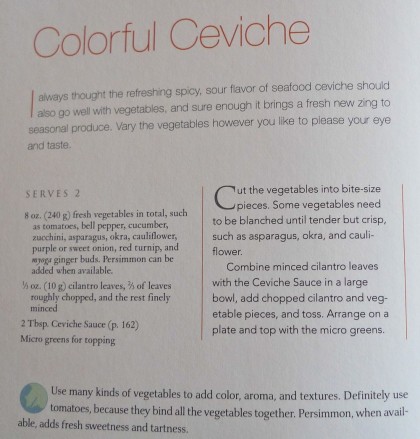
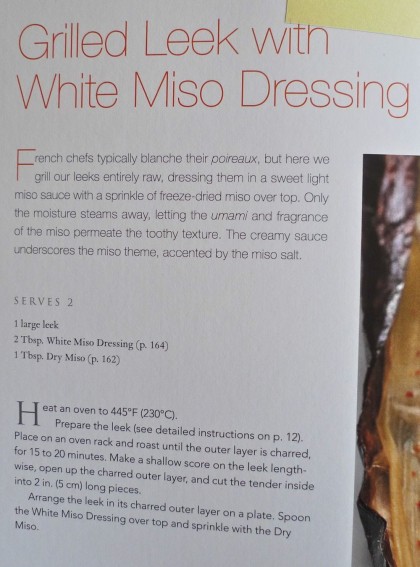
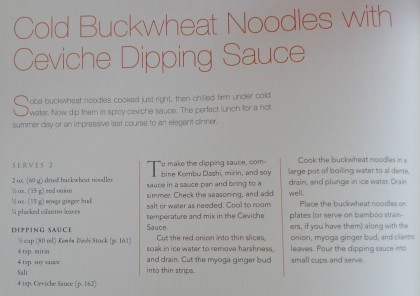 The Sourcing
The Sourcing
I put the cooking off for months. With summer came tomatoes and corn, which we tend to prefer as simply prepared as possible. Finally, out at the house we rent in Litchfield, Conn., I announced we would be cooking from Nobu’s Vegetarian Cookbook and that was that. (I’m kind of tired of corn and tomatoes.) That meant trucking up a lot of the ingredients, because I knew the Stop & Shop would be useless. I think I’m getting a reputation there as the guy who buys the weird vegetables—radicchio, frisée, turnips, radishes….
Remarkably, we already had mirin, yuzu juice (yuzu is like a lemon crossed with a tangerine), grapeseed oil, and rice vinegar. Feeling stung by Suzanne’s comment about a cookbook reader who made a mockery of a recipe, I decided I’d go the extra mile to track down the other ingredients. I walked up to Sunshine Market on Broome, where I found kombu, soba, and Kewpie mayonnaise (we decided to make Andrew Carmellini’s okonomiyaki-style corn on the cob for another meal), and I hauled myself up to Kalustyan’s for the aji amarillo paste. (Thanks for the tip to eat in the restaurant above the store!) I did skip the “micro greens for topping” and “myoga ginger buds.” Life is too short.
The Cooking
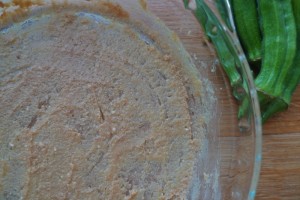 I started by making the Dry Miso. You spread it in dish (a spatula seemed to work instead of the required palette knife) and stick it in the oven for “1 to 2 hours, being careful not to allow the miso to darken.” The house has a propane oven that burns very hot, so I set the temperature lower and the timer for 30 minutes.
I started by making the Dry Miso. You spread it in dish (a spatula seemed to work instead of the required palette knife) and stick it in the oven for “1 to 2 hours, being careful not to allow the miso to darken.” The house has a propane oven that burns very hot, so I set the temperature lower and the timer for 30 minutes.
Then I set to work on the Ceviche Sauce, a mix of lemon juice, yuzu juice, garlic, ginger, soy sauce, and aji amarillo paste. It was so tasty I wanted to drink it.
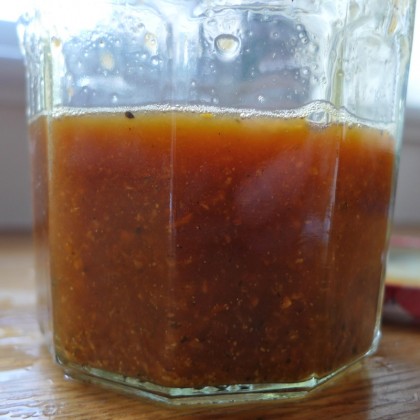 I peeked at the Dry Miso, which looked–and smelled—good. The timer was set for another half hour. On to the Miso Dressing: white miso, garlic, grapeseed oil, and rice vinegar. Another winner!
I peeked at the Dry Miso, which looked–and smelled—good. The timer was set for another half hour. On to the Miso Dressing: white miso, garlic, grapeseed oil, and rice vinegar. Another winner!
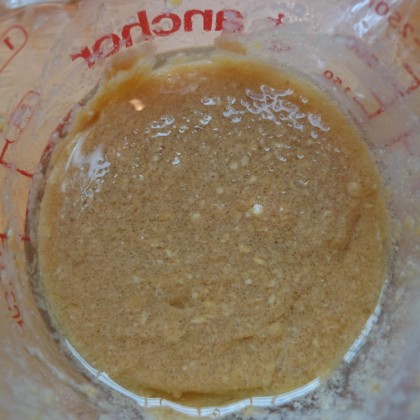 Time to check the dry miso again….
Time to check the dry miso again….
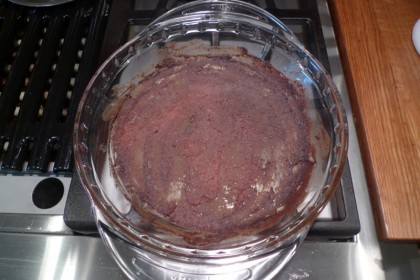
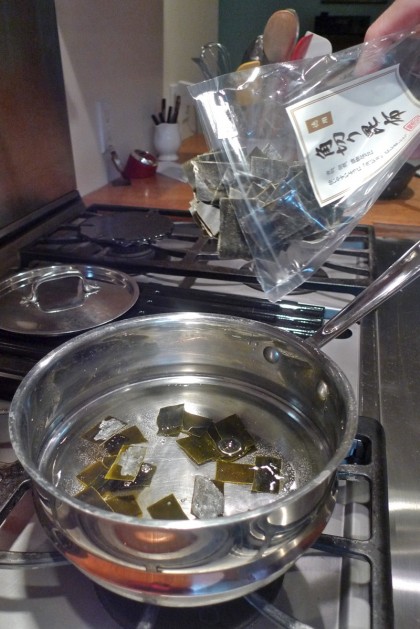
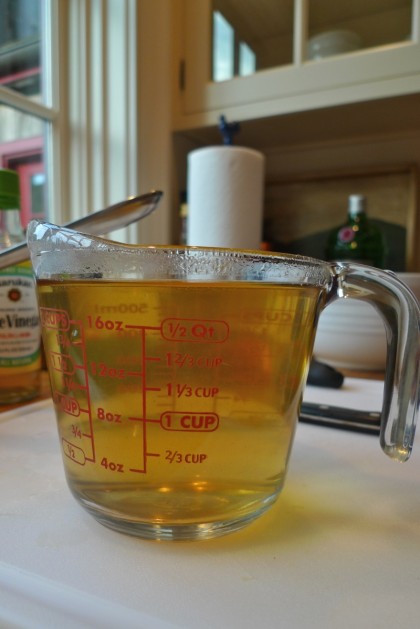 Oh. Well, it didn’t seem essential.
Oh. Well, it didn’t seem essential.
I asked Adam to deal with the Kombu Dashi. The recipe isn’t complex—you steep seaweed in 140-degree water for 50 minutes—but in light of recent events, I didn’t trust my ability to keep the cooktop (also propane) at a steady low temperature. Remarkably, (a) the house had a thermometer, and (b) the cooktop’s lowest setting kept the Kombu Dashi at 140 degrees! The book says you should strain the broth through a sieve and a kitchen towel, but I wasn’t sure the owners of the house would appreciate that. Rather than decide that “kitchen towel” is how “paper towel” translates from Japanese, we hoped that a fine-mesh sieve would do. It looked OK, not that we would know better, and the kitchen smelled like a Japanese restaurant.
Soba, we learned, doesn’t swell up like pasta, so we ended up with fewer noodles than we had expected. And we weren’t quite sure what was missing from the “1/4 plucked cilantro leaves.”
The Bottom Line
Even with prepping instructions that made no sense whatsoever—and even without the Dry Miso—the silky, creamy leeks were the high point. To be honest, we might have preferred them without any of the White Miso Dressing, but then we probably put too much of it on. (And this being a rental house, we didn’t have a sharp knife, so we ended up with a pile rather than the book’s suggested presentation.)
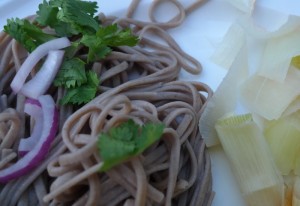
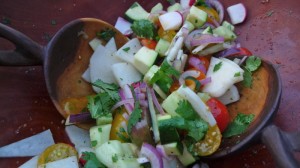 Adam thought the soba wasn’t as good as at soba restaurants, but I still enjoyed it—the huge amounts of cilantro and Ceviche Dipping Sauce I put on it had to help.
Adam thought the soba wasn’t as good as at soba restaurants, but I still enjoyed it—the huge amounts of cilantro and Ceviche Dipping Sauce I put on it had to help.
The Colorful Ceviche wasn’t a ceviche by any definition I know. The vegetables don’t “cook” at all. (Maybe if you let them marinate, but the recipe mentions no such thing.) It was a chopped salad—a nice change-up from a chopped salad with a normal vinaigrette, and healthy as can be (vegan, no oil), but also sort of blah. Maybe springier vegetables (asparagus, peas, snap peas) would’ve helped. Or fewer types of veggies: I blanched the okra but forgot to include it, so I had it the next day at lunch with the Ceviche Sauce, and it was marvelous.
And two weeks later, I incorporated the White Miso dressing in several vinaigrettes, each of which had a mysterious deliciousness that I credit to the miso.
The takeaway, then, is that the dressings and sauces section—relegated to the back of the book—is the keeper.
6 Comments
Subscribe
Subscribe to the TC Newsletter







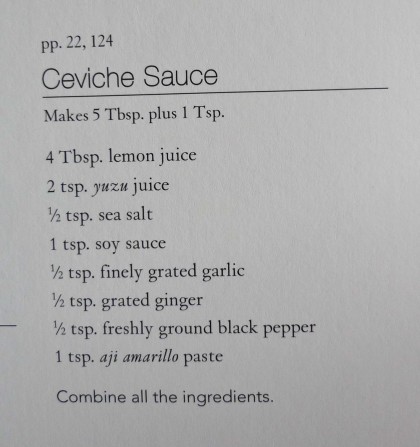
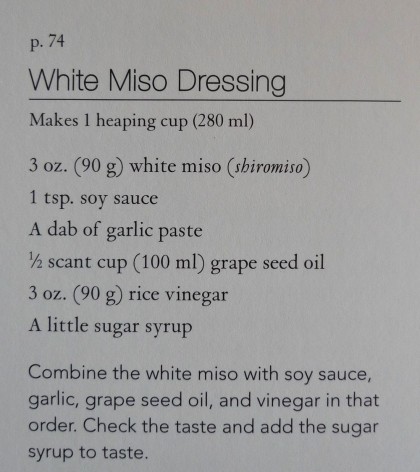
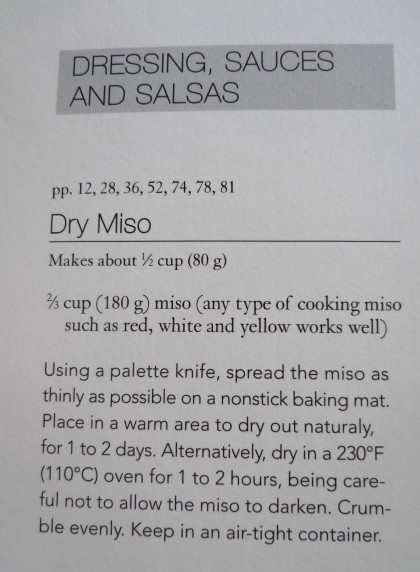
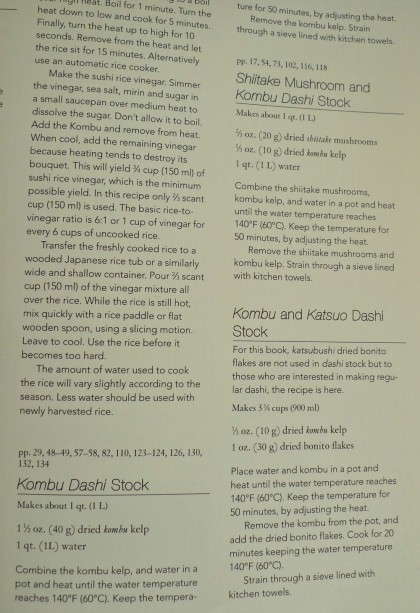







Thank you for another great Cookbook review/Cooking adventure post.
You effectively highlight the strengths and weakness of the book and it’s fun to be in the kitchen with you and Adam.
I can almost smell the Kombu Dashi and I think I need to have Ceviche sauce for lunch today.
Wow. This was impressive. Thanks or sharing.
When is sushi of gare opening on Duane and West Broadway?
@Katie: Mid-month was the last I heard, but I’d assume that gets pushed back a bit https://tribecacitizen.wpengine.com/2012/09/04/progress-report-september-2012/
Oh, Erik, now I feel terrible for hurting your feelings. I didn’t mean to, really. I just wanted to show what happens when someone screws with a recipe ad absurdum. You don’t do that. (Or if you do, I don’t want to know!)
Other than that: thanks for the review, and for all your hard work making the recipes. I did NOT work on this book; if I had, it wouldn’t have been the jumble of weights and volumes, missing units of measure (probably 1/4 cup cilantro leaves”), and “4 Tbsp.” where “1/4 cup” is easier for the cook.
For future reference, yeah, paper towels, preferably unprinted ones, work fine for straining. And here’s a hint: dampen them with water and wring them out before you put them in the strainer; they won’t absorb as much of whatever it is you’re straining.
Another hint: if you use glass for baking (as you had to with the miso), lower the (regular oven) temperature by about 25 degrees F. If you don’t have a nonstick baking mat (aka silicone, aka Silpat), just use a piece of waxed paper or cooking/kitchen parchment paper. Get some at the Stop & Shop next time you’re up there. And an oven thermometer, too. It will really be a help to know the temp inside the oven.
If you have other cooking questions, you know how to reach me!
@Suzanne: Thanks for the advice! (I thought about parchment paper—I had some—but since it’s sold in rolls I wasn’t sure how to have the sheet just roll up on itself.) I’m sure the advice will come in handy as I tackle Karen DeMasco’s “The Craft of Baking”….